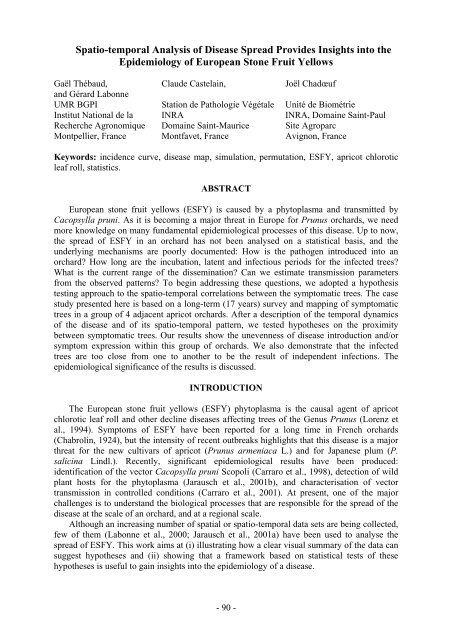Ecole Nationale Supérieure Agronomique de Montpellier ... - CIAM
Ecole Nationale Supérieure Agronomique de Montpellier ... - CIAM
Ecole Nationale Supérieure Agronomique de Montpellier ... - CIAM
Create successful ePaper yourself
Turn your PDF publications into a flip-book with our unique Google optimized e-Paper software.
Spatio-temporal Analysis of Disease Spread Provi<strong>de</strong>s Insights into the<br />
Epi<strong>de</strong>miology of European Stone Fruit Yellows<br />
Gaël Thébaud, Clau<strong>de</strong> Castelain, Joël Chadœuf<br />
and Gérard Labonne<br />
UMR BGPI<br />
Institut National <strong>de</strong> la<br />
Recherche <strong>Agronomique</strong><br />
<strong>Montpellier</strong>, France<br />
Station <strong>de</strong> Pathologie Végétale<br />
INRA<br />
Domaine Saint-Maurice<br />
Montfavet, France<br />
- 90 -<br />
Unité <strong>de</strong> Biométrie<br />
INRA, Domaine Saint-Paul<br />
Site Agroparc<br />
Avignon, France<br />
Keywords: inci<strong>de</strong>nce curve, disease map, simulation, permutation, ESFY, apricot chlorotic<br />
leaf roll, statistics.<br />
ABSTRACT<br />
European stone fruit yellows (ESFY) is caused by a phytoplasma and transmitted by<br />
Cacopsylla pruni. As it is becoming a major threat in Europe for Prunus orchards, we need<br />
more knowledge on many fundamental epi<strong>de</strong>miological processes of this disease. Up to now,<br />
the spread of ESFY in an orchard has not been analysed on a statistical basis, and the<br />
un<strong>de</strong>rlying mechanisms are poorly documented: How is the pathogen introduced into an<br />
orchard? How long are the incubation, latent and infectious periods for the infected trees?<br />
What is the current range of the dissemination? Can we estimate transmission parameters<br />
from the observed patterns? To begin addressing these questions, we adopted a hypothesis<br />
testing approach to the spatio-temporal correlations between the symptomatic trees. The case<br />
study presented here is based on a long-term (17 years) survey and mapping of symptomatic<br />
trees in a group of 4 adjacent apricot orchards. After a <strong>de</strong>scription of the temporal dynamics<br />
of the disease and of its spatio-temporal pattern, we tested hypotheses on the proximity<br />
between symptomatic trees. Our results show the unevenness of disease introduction and/or<br />
symptom expression within this group of orchards. We also <strong>de</strong>monstrate that the infected<br />
trees are too close from one to another to be the result of in<strong>de</strong>pen<strong>de</strong>nt infections. The<br />
epi<strong>de</strong>miological significance of the results is discussed.<br />
INTRODUCTION<br />
The European stone fruit yellows (ESFY) phytoplasma is the causal agent of apricot<br />
chlorotic leaf roll and other <strong>de</strong>cline diseases affecting trees of the Genus Prunus (Lorenz et<br />
al., 1994). Symptoms of ESFY have been reported for a long time in French orchards<br />
(Chabrolin, 1924), but the intensity of recent outbreaks highlights that this disease is a major<br />
threat for the new cultivars of apricot (Prunus armeniaca L.) and for Japanese plum (P.<br />
salicina Lindl.). Recently, significant epi<strong>de</strong>miological results have been produced:<br />
i<strong>de</strong>ntification of the vector Cacopsylla pruni Scopoli (Carraro et al., 1998), <strong>de</strong>tection of wild<br />
plant hosts for the phytoplasma (Jarausch et al., 2001b), and characterisation of vector<br />
transmission in controlled conditions (Carraro et al., 2001). At present, one of the major<br />
challenges is to un<strong>de</strong>rstand the biological processes that are responsible for the spread of the<br />
disease at the scale of an orchard, and at a regional scale.<br />
Although an increasing number of spatial or spatio-temporal data sets are being collected,<br />
few of them (Labonne et al., 2000; Jarausch et al., 2001a) have been used to analyse the<br />
spread of ESFY. This work aims at (i) illustrating how a clear visual summary of the data can<br />
suggest hypotheses and (ii) showing that a framework based on statistical tests of these<br />
hypotheses is useful to gain insights into the epi<strong>de</strong>miology of a disease.



